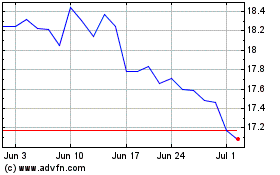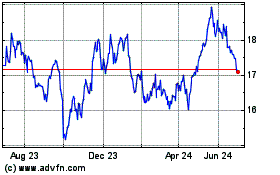Utility agrees to pay $11 billion to firms; no deal yet with
victims
By Peg Brickley and Russell Gold
This article is being republished as part of our daily
reproduction of WSJ.com articles that also appeared in the U.S.
print edition of The Wall Street Journal (September 14, 2019).
PG&E said it has reached an $11 billion settlement with
insurance companies over wildfire claims, a significant step toward
emerging from bankruptcy.
The deal covers insurance carriers and hedge funds that were
seeking compensation from PG&E for payouts insurers made to
homeowners and businesses in connection with fires sparked by the
utility's equipment.
It leaves wildfire victims as the only major group of claimants
that has not reached a settlement with the San Francisco utility,
which is pushing to emerge from bankruptcy next year.
The settlement is the second major agreement PG&E has
reached with claimants. In June, PG&E agreed to pay $1 billion
to local governments and state agencies to settle claims from fires
in 2017 and 2018, obtaining their support for the company's
bankruptcy plan.
Representatives for wildfire victims criticized the settlement
Friday, saying the company appeared to be trying to isolate those
who lost homes and lives to the fires.
"PG&E is taking money out of the pockets of people whose
homes and businesses it burned down and handing the money to
insurance companies to buy their cooperation," said Cecily Dumas,
one of the lead lawyers representing fire victims in the
bankruptcy. "This settlement violates the rights of the victims
under California law to be compensated first. The settlement shows
that PG&E puts victims' needs last."
The settlement was negotiated with carriers that hold roughly
85% of so-called insurance subrogation claims against the company,
which allow insurance companies to pursue those deemed responsible
for damage.
A PG&E spokeswoman said she expected the deal would cover
all insurance claims. PG&E added that it was continuing to work
to resolve claims with individual plaintiffs.
PG&E has been negotiating for some time with insurance
companies that own claims for fire damage payments, including
affiliates of Farmers Insurance Exchange and Hartford Accident
& Indemnity Co., as well as Baupost Group LLC, a hedge fund
that bought more than $2.5 billion worth of insurance claims.
"We hope that this compromise will pave the way for a plan of
reorganization that allows PG&E to fairly compensate all
victims," a spokesman for the insurance group said in a
statement.
PG&E, which provides gas and electric service to 16 million
people, f iled for bankruptcy protection earlier this year, citing
$30 billion in liabilities from a series of deadly and destructive
wildfires sparked by its equipment.
Since then, it has begun inspecting and repairing thousands of
miles of its wires to reduce the risk of sparking future wildfires
-- and it has been engaged in complex negotiations with California
lawmakers, claimants, bondholders and shareholders to restore the
century-old company to firm financial footing.
PG&E faces a June 30, 2020, deadline to exit bankruptcy if
it wants to participate in a fund being set up by California to
help utilities pay for wildfire-related damages, which are growing
as the state deals with the impacts of drought and climate
change.
For the past several months, the company has been battling
insurers and wildfire victims over how much it should set aside to
cover existing fire-related damages. The settlement with insurers
will ultimately include a support agreement that requires the
insurers to favor PG&E's plan to exit from bankruptcy,
according to a person familiar with the matter.
Final papers have yet to be prepared on the insurance
settlement.
California fire investigators have found that PG&E equipment
sparked numerous fires in the state in 2017 and 2018, including
last November's Camp Fire, which killed 86 people and destroyed the
town of Paradise. But state investigators concluded that the
company didn't cause the most destructive 2017 fire, known as the
Tubbs Fire.
Lawyers representing fire victims strongly dispute that
conclusion, and PG&E's culpability in the Tubbs Fire is now set
for a state trial, creating significant uncertainty about the total
liability the company faces.
The settlement with insurers, which involves both PG&E Corp.
and its Pacific Gas and Electric Co. utility, is subject to the
approval of the bankruptcy court overseeing PG&E's Chapter 11
plan.
On Monday PG&E unveiled an $18 billion plan to resolve all
wildfire-related claims and exit bankruptcy next year as it seeks
to prevent creditors from taking over the embattled company.
That plan disappointed representatives for fire victims, who
have said in court filings that they are owed $54 billion, and the
ultimate figure PG&E has to pay may wind up being substantially
higher.
With the tentative settlements to insurance companies and local
governments, PG&E has already struck deals for a combined $12
billion to settle claims, excluding fire victims.
The company said it still planned to raise $14 billion in new
equity to pay claims, according to papers filed with the U.S.
Bankruptcy Court in San Francisco. PG&E said it has received
commitments of $1.5 billion and will seek remaining equity
financing commitments over the next several weeks.
--Dave Sebastian contributed to this article.
Corrections & Amplifications PG&E said it has reached an
agreement with 85% of insurance subrogation claim holders to settle
all such claims related to the 2017 Northern California wildfires
and 2018 Camp Fire. An earlier version of this article incorrectly
said the company agreed to resolve the majority of claims. (Sept.
13, 2019)
Write to Peg Brickley at peg.brickley@wsj.com and Russell Gold
at russell.gold@wsj.com
(END) Dow Jones Newswires
September 14, 2019 02:47 ET (06:47 GMT)
Copyright (c) 2019 Dow Jones & Company, Inc.
PG&E (NYSE:PCG)
Historical Stock Chart
From Mar 2024 to Apr 2024

PG&E (NYSE:PCG)
Historical Stock Chart
From Apr 2023 to Apr 2024
